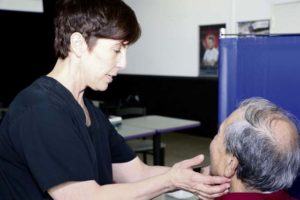by Alofagia Oney
Landstuhl Regional Medical Center Public Affairs
In honor of April’s National Head and Neck Cancer Awareness Month, medical providers from the Ear, Nose and Throat Clinic, Oral Surgery Clinic and Speech-Language Pathology Department at Landstuhl Regional Medical Center held a head and neck cancer screening event at both the hospital and the Ramstein Exchange April 17 where over 130 people from the community were evaluated.

During the five-minute screenings, patients were examined for signs and symptoms of head and neck cancers and were provided education on ways to detect and prevent them.
“The patient demographic has changed, mostly due to the rise in the frequency of the Human Papilloma virus, or HPV, which is associated with head and neck cancers” said Maj. Whitney Pafford, an otolaryngologist at the LRMC ENT clinic. “Whereas we used to see a predominance of head and neck cancers in older folks, we are now seeing them in people of all ages, even as young as 19, who have never smoked or drank alcohol a day in their lives.”
Risk factors for head and neck cancers include tobacco, alcohol – the combination of smoking and drinking alcohol can more than double a person’s risk – genetics, ultraviolet exposure from the sun, poor dental hygiene and viruses like HPV, among others.
According to the Centers for Disease and Prevention Control, more than 110,000 people in the United States over the age of 18 are diagnosed with head and neck cancer, and more than 40 percent of those who are diagnosed die within five years.
Head and neck cancers have surpassed cervical cancer in HPV related malignancies. Nearly 80 percent of these patients are men who are unaware they were exposed to the virus, according to the CDC.
“The good news is that early diagnosis can more than double a patient’s chance of survival, up to nearly 90 percent,” Pafford said. “The vaccine against HPV is approved for children as early as 11 years old, and when the HPV vaccine is received before exposure, it can prevent about 70 to 90 percent of these cancers.”
During the event, providers looked for a variety of signs and symptoms such as mouth sores, pain or difficulty swallowing, red or white patches in the mouth, recurrent bleeding in the nose or mouth and numbness in certain parts of the face.
“It’s important that people who experience some of the signs or symptoms don’t jump to conclusions and automatically assume they have a head and neck cancer,” said Pafford. “However, lesions, lumps or persistent symptoms for more than 14 days should be evaluated by a professional.”
In addition to providers from the ENT clinic, Tracey Fischer, a speech pathologist at LRMC, was also present at the screening event to examine patients. While speech-language pathologists typically treat patients who have problems with speech, language and cognition, they are also specially trained to identify, evaluate and treat dysfunction of the muscles in the head, neck, tongue and mouth.
While the Head and Neck Cancer Screening event only lasted for one day, Pafford encourages people to either consult their primary care providers or conduct a head and neck cancer self-exam if they have concerns.
“Education is a big part of the process of early detection,” Pafford said. “The more you know about the signs and symptoms, the better you and your providers are able to properly receive treatment if you are diagnosed.”
For more information on head and neck cancers, visit www.cdc.gov/cancer/headneck.







